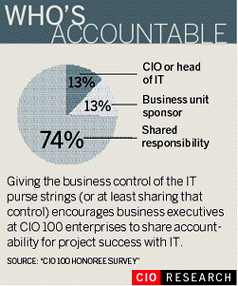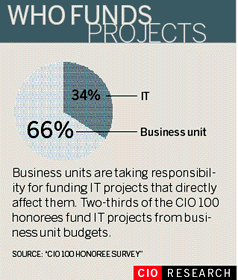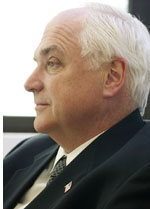Entrepreneur and Business Resources
Integral Methods and Technology
Governance and Investor Responsibility
|
CIO as a Venture Capitalist
Aug. 15, 2003 Issue of CIO Magazine | The Resourceful 100
GOVERNANCE
Deciding Factors
STUART SCOTT MAY BE the
vice president and CIO of GE Industrial Systems, but he sees himself as
a venture capitalist. He and his colleagues on the investment council,
which includes the CFO and the heads of manufacturing and engineering,
sort through a tantalizing array of business and IT projects every couple
of weeks during budget season to determine how best to invest the company's
money. "The way I view my job, I'm a VC. I've got things I'm trying to
achieve for the business and for GE shareholders," he says.
Like any VC who wants to stay in business, Scott constantly looks for
the highest possible return, subjecting potential investments to a level
of scrutiny that can only be described in polite company as rigorous.
While Scott's governance practices aren't for the faint of heart, they
consistently generate good results. This rigorous governance is one of
the best ways to foster resourcefulness. "People think of governance as
something very constraining and resourcefulness as something innovative,
but in fact, governance is a core component of resourcefulness," says
Howard Rubin, executive vice president at Meta Group. "It's hard to foster
resourcefulness without governance." In other words, a solid governance
structure promotes resourceful thinking within an organization. Here's
a look at the top governance practices of some of the CIO 100 honorees
and how they're putting them to work to encourage resourcefulness and
create value.
![]() Scrutinize For Value
Scrutinize For Value
Treat each IT project as an investment, and recognize when it's time to
cut loose projects that aren't delivering sufficient value.
 STUART SCOTT, CIO of GE Industrial Systems, considers himself
a venture capitalist and makes decisions based primarily on how
they will impact investors and the business.
STUART SCOTT, CIO of GE Industrial Systems, considers himself
a venture capitalist and makes decisions based primarily on how
they will impact investors and the business. |
Treating IT projects as investments requires going beyond tracking whether projects are on time and on budget, says Meta Group's Rubin. If the market changes, a project may not produce the desired outcome, even if it's early and under budget. Rubin advises tracking whether projects are on time, on budget, and on scope and on value.
It is also important to subject all projects, even infrastructure upgrades, to the same stringent approval process as any other IT project. AARP CIO of IT Solutions John Sullivan put his request for a mainframe upgrade alongside an enhancement for the marketing campaign management system, even though it's hard to discuss back-office technology in terms of business value. "I want the organization to get in the habit of making sure everyone—including me and my staff—can articulate clearly why we're spending our members' money on anything that we do," he explains.
The annals of IT history are filled with horror stories of business folks lobbing requests for IT projects over the wall, then grousing when the results don't meet their needs. Today, requiring formal written project requests is a staple of resourceful governance. The act of committing IT requests to paper is the first step toward ensuring that an IT organization is putting its budget and staff to work on the highest-priority projects.
 Project request templates can be relatively informal or highly detailed.
World Wildlife Fund (WWF) encourages business executives to complete a business
case template, which asks for specific metrics such as a 2 percent increase
in donations or a 24-hour decrease in payroll processing time. Those who
don't fill out a template are much less likely to get a project approved,
says Vice President of IT and CIO Gregory S. Smith. "It's really designed
to get the business to start thinking about how this project or enhancement
will add value to WWF, not just 'This is what I want to do,'" he says. "They
find out very quickly if they can't define any project benefits." The template
helps WWF weed out less important projects and focus on those that will
deliver the most value.
Project request templates can be relatively informal or highly detailed.
World Wildlife Fund (WWF) encourages business executives to complete a business
case template, which asks for specific metrics such as a 2 percent increase
in donations or a 24-hour decrease in payroll processing time. Those who
don't fill out a template are much less likely to get a project approved,
says Vice President of IT and CIO Gregory S. Smith. "It's really designed
to get the business to start thinking about how this project or enhancement
will add value to WWF, not just 'This is what I want to do,'" he says. "They
find out very quickly if they can't define any project benefits." The template
helps WWF weed out less important projects and focus on those that will
deliver the most value. The number of project requests at AARP has dropped dramatically since it deployed an online portfolio management tool. "They line up support and develop their idea before making [a request]," says Sullivan.
The opportunity to reuse software and hardware—the CIO's equivalent of getting a box of hand-me-downs—is resourcefulness defined. A well-governed IT shop will make consideration of reuse a part of its standard operating procedure. (To read more about resourceful reuse policies, see "Déjà New.") Northeastern University has formalized its reuse philosophy into an official methodology it calls the Assemble Approach. The university first leverages existing resources, then buys the best application needed, then builds what can't be bought. Following the Assemble Approach, Northeastern VP of IS Robert Weir's team leveraged existing resources—legacy systems including the financial aid, admission and registration applications—to develop a student Web portal in just 90 days. MyNEU features a single sign-on ability and lets students access e-mail and class calendars, register, drop and add classes, and use student-developed applications.
Time is money, so a company that completes IT projects faster is doing a better job of managing its resources. One of the most effective ways to build speed into the culture—and ensure that benefits are still relevant when they are realized—is to mandate delivery of value on short deadlines.
 At GE Industrial Systems, small projects must achieve payback in less than
one year, large projects in less than two years—and project time frames
and budgets become tighter every year. (Only compliance projects, like those
required by Sarbanes-Oxley, are exempt from the strict time limit.) "We
should be implementing every year 50 percent faster at half the cost," insists
Scott. "If it cost us $1 to put in a general ledger, it should cost 50 cents
next year. If it took six months, then it should take three next year. We
recently did an Oracle implementation in four weeks." Whether the policy
of halving cost and time annually is sustainable remains to be seen. While
the cost and time savings have been significant, Scott jokes that he hopes
he will have been promoted before he has to ask his team to do something
like implement ERP in a week.
At GE Industrial Systems, small projects must achieve payback in less than
one year, large projects in less than two years—and project time frames
and budgets become tighter every year. (Only compliance projects, like those
required by Sarbanes-Oxley, are exempt from the strict time limit.) "We
should be implementing every year 50 percent faster at half the cost," insists
Scott. "If it cost us $1 to put in a general ledger, it should cost 50 cents
next year. If it took six months, then it should take three next year. We
recently did an Oracle implementation in four weeks." Whether the policy
of halving cost and time annually is sustainable remains to be seen. While
the cost and time savings have been significant, Scott jokes that he hopes
he will have been promoted before he has to ask his team to do something
like implement ERP in a week. At Hershey Foods, project requests used to pour in so frequently that Vice President and CIO George F. Davis jokes that even the janitor could submit a half-million-dollar IT request. Now, projects rarely take longer than a year. To expedite the request process, the company introduced a triage system. All requests are immediately classified as small (IT staff can handle within 10 days), medium (requiring more than 10 days and costing up to $249,999) or large (projects costing more than $250,000). The IS staff handles the small projects. Each medium project is slated for further discussion with the head of the business unit that proposed it. All large projects go before the IS advisory committee, which focuses on the most important projects.
"Our goal is to provide timely feedback," says George Spanos, director of logistic and sales systems (who is also in charge of Hershey's project management office). "The answer might be, 'No' or it might be, 'We need to discuss it at this meeting on this date,' but it's a lot better than not hearing anything."
 At GE Industrial Systems, if an IT project proposal claims it will save
$1 million, then $1 million is taken from the project owner's budget once
the project is approved—period. "It's a significant sign-up by the
functional owner, who is then committed to deliver," says Scott. "We've
just found if programs become 'free money,' then everyone has a great project
idea. You end up playing liar's poker to find out who's really telling the
truth. This eliminates all that. No one comes to us unless they believe
in it." And taking money out of someone's budget is a foolproof way to ensure
that it won't be spent.
At GE Industrial Systems, if an IT project proposal claims it will save
$1 million, then $1 million is taken from the project owner's budget once
the project is approved—period. "It's a significant sign-up by the
functional owner, who is then committed to deliver," says Scott. "We've
just found if programs become 'free money,' then everyone has a great project
idea. You end up playing liar's poker to find out who's really telling the
truth. This eliminates all that. No one comes to us unless they believe
in it." And taking money out of someone's budget is a foolproof way to ensure
that it won't be spent. Fully 75 percent of CIO 100 honorees manage their IT projects as a portfolio—an excellent strategy for keeping sight of the forest through the trees (to Read More, see "Portfolio Management: How to Do It Right"). At Hershey Foods, a portfolio management system from ProSight has simplified the advisory committee's task of prioritizing IT projects. Instead of asking for the committee's feedback on one project at a time, CIO Davis and his team put some 20 to 30 large projects in context, showing their estimated dollar value and how they align with the company strategy. Davis says that despite tight budgets, his IT project budget doubled this year. "We got twice as much capital this year as we've ever gotten," he says. "We were able to articulate the value and show how projects align with the strategy of the company. It's a direct result of portfolio management."
 Mony Group CIO E.P. ROGERS has transformed his IT group from
being mostly operational in function to an even mix of operational
and strategic.
Mony Group CIO E.P. ROGERS has transformed his IT group from
being mostly operational in function to an even mix of operational
and strategic. |
Once you have a portfolio of IT investments, safeguard those investments by making sure they're managed by experts. Project management offices (PMOs) increase the chances of success for IT projects. Expert project managers create and consistently employ best practice project methodologies. Bruce J. Goodman, senior vice president and chief service and information officer of insurance company Humana, says that even if he has no budget, he'll continue to hire project managers. Their skills are in such demand that his PMO "loans" out its project managers to other parts of the organization.
Checking to see whether IT projects deliver on promised value may seem like an obvious best practice, but Rubin says that auditing is relatively uncommon. Among the elite group of this year's CIO 100 honorees, however, 65 percent say they do post-implementation audits always or frequently.
 Project managers are in such demand at Humana that CIO BRUCE
GOODMAN "loans" out their services to other departments within the
company.
Project managers are in such demand at Humana that CIO BRUCE
GOODMAN "loans" out their services to other departments within the
company. |
At hardware retailer Chase Pitkin, CIO T. Christopher Dorsey also happens to be the controller. Not surprising, he and the CEO consider only hard-dollar ROI when analyzing projects. Dorsey builds in specific metrics, and checks results monthly against P&L statements. For example, he found employees weren't always calculating special-order delivery charges correctly. After deploying a special-order system that automatically calculates delivery costs, Dorsey was able to determine the value of adding that function when the line item for home delivery income increased by 59 percent.
 A governance structure that is too constraining or draconian will alienate
the businesspeople you're trying to engage to help set IT priorities. It's
important to strike the right balance. "We had too much governance in the
wrong places, or none at all," recalls Humana's Goodman. For example, he
has eliminated the old practice of agonizing every month over how many full-time
equivalent IT employees should be devoted to each business area. Instead,
he shoots for the right range, based on his best estimate. "We try to keep
bureaucracy to a minimum," he says.
A governance structure that is too constraining or draconian will alienate
the businesspeople you're trying to engage to help set IT priorities. It's
important to strike the right balance. "We had too much governance in the
wrong places, or none at all," recalls Humana's Goodman. For example, he
has eliminated the old practice of agonizing every month over how many full-time
equivalent IT employees should be devoted to each business area. Instead,
he shoots for the right range, based on his best estimate. "We try to keep
bureaucracy to a minimum," he says. Communicating to set the right tone and ensure that everyone involved understands your governance processes is also critical. The goal should be to avoid ambiguity and surprises. "Governance by definition is somewhat constraining," says GE's Scott. "It's not a free-for-all. It's meant to control. I try to communicate up front about what is the governance process, how does it work, and how people can be successful as project leaders."
Whatever governance you have in place today, be ready to adapt it to make the most of tomorrow's business conditions. "My governance has evolved," says GE's Scott. "My governance process five years from now will be different. It will be adjusted to whatever the requirements are at time. In the end, governance is forced upon us by the environment in which we work."
| More Governance Best Practices |
| Effective
governance promotes resourcefulness. Here are four more best practices
of this year’s CIO-100 winners. |
Contact Senior Editor Alice Dragoon via e-mail at adragoon@cio.com.